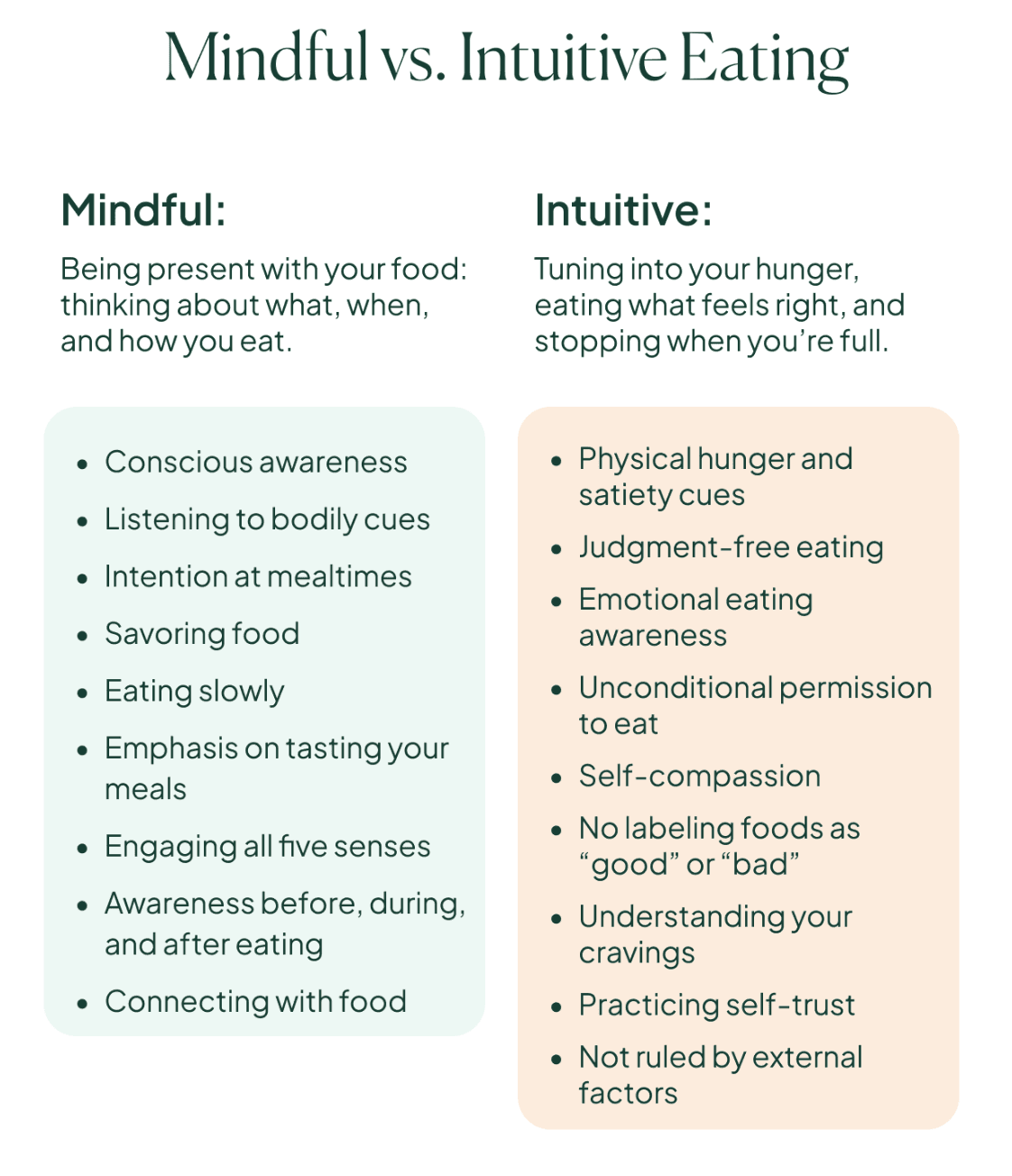Author:
Clinically Reviewed By:
You’ve probably seen both “mindful eating” and “intuitive eating” trending on social media, in wellness books, or even in therapy settings. They sound similar, but they’re two different approaches to building a healthier relationship with food.
At Berry Street, many clients come to us confused: Should I be eating mindfully? Should I go fully intuitive? Which is right for me?
A registered dietitian can help you with all these questions, and you can find an intuitive eating dietitian who helps you reconnect with intuitive eating principles through Berry Street's online nutrition counseling.
The truth is that both methods can be powerful tools. The best approach depends on your goals, your relationship with food, and your stage of life.
What Is Mindful Eating?
Mindful eating comes from the practice of mindfulness, which is being fully present in the moment without judgment. Applied to food, it means slowing down, noticing your hunger and fullness signals, and being aware of the experience of eating.
Some of the main principles of mindful eating include:
Eating without distractions (like phones or TV)
Paying attention to the taste, texture, and smell of food
Checking in with your hunger levels before and during meals
Pausing to notice satisfaction and satiety cues
Recognizing emotional vs. physical hunger

The Benefits of Mindful Eating
Reduces overeating and binge tendencies
Improves digestion by slowing the meal pace
Enhances the enjoyment of food
Helps break the cycle of emotional eating
What Is Intuitive Eating?
Intuitive eating is a framework created by dietitians Evelyn Tribole and Elyse Resch in the 1990s. It focuses on rebuilding trust with your body by tuning into hunger and fullness cues, letting go of diet rules, and making peace with food.
It is structured around 10 principles, including:
Rejecting the diet mentality
Honoring hunger
Making peace with food
Challenging the “food police”
Respecting fullness
Discovering satisfaction
Coping with emotions without food
Respecting your body
Joyful movement
Gentle nutrition

The Benefits of Intuitive Eating
Improves body image and reduces guilt around food
Supports stable weight without dieting
Helps normalize eating patterns after restrictive diets
Encourages flexibility and food freedom
The Differences Between Mindful Eating vs. Intuitive Eating

Both approaches overlap - they encourage awareness, respect for hunger cues, and enjoyment of food - but they’re not identical.
Which Approach Is Right for You?
As dietitians, we know that choosing between mindful eating and intuitive eating depends on your personal goals, health needs, and current relationship with food. For some people, mindful eating is the most helpful starting point. If you often eat quickly, multitask while eating, or struggle with portion awareness, practicing mindfulness at meals can help you slow down, tune in, and fully enjoy your food. It can also be a great tool for reducing emotional eating and building a more satisfying connection with what you eat.
On the other hand, intuitive eating may be the right path if you’ve tried multiple diets without long-term success, if you feel guilt or shame after eating, or if you’re ready to let go of rigid food rules. This approach focuses on rebuilding body trust, working through food fears, and improving body image while creating a flexible, compassionate relationship with food.
In many cases, we use both together, teaching mindful eating as a practical tool within an intuitive eating framework. This allows clients to not only become more present with their meals but also to step away from diet culture and move toward lasting, sustainable change.

What the Science Has to Say About Both Methods
Both mindful eating and intuitive eating are rooted in strong scientific evidence, and each can play a meaningful role in building a healthier relationship with food.
Mindful eating has been studied for its impact on its effects on digestion, reducing binge eating disorder, emotional eating, and even stress-related overeating. By slowing down and paying attention to hunger cues, fullness, and the sensory experience of eating, mindful practices can improve self-awareness and support weight management in a sustainable way.
Intuitive eating, meanwhile, has been linked in research to improved psychological well-being, reduced disordered eating, and greater body satisfaction. Studies also show that people who practice intuitive eating often have lower body mass indexes (BMI) and better long-term health markers. The benefits of this approach lies in its focus on rejecting diet culture, rebuilding trust with your body, and making food choices without guilt or shame.
What’s important to understand is that neither mindful eating nor intuitive eating is meant to be a quick fix. Instead, they’re long-term, evidence-based strategies designed to help you feel more in control, improve your overall health, and create a more peaceful, empowered relationship with food.
Practical Tips to Try
For Mindful Eating:
Eat one meal a day without screens.
Put your fork down between bites.
Pause halfway through and rate your hunger.
Notice flavors and textures as if eating them for the first time.
For Intuitive Eating:
Write down the diet rules you want to release.
Keep a hunger/fullness journal.
Stock your pantry with foods you once considered “off-limits.”
Explore gentle nutrition—adding foods for health without restriction.













